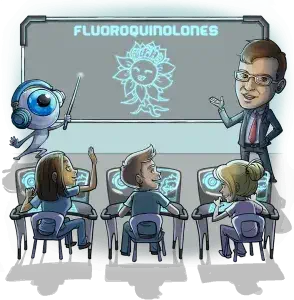With a myriad of study methods available to students, you may have wondered: Am I getting the most out of my study sessions? Traditionally, students are taught to read and re-read the textbook, highlight words and definitions, and write notes about what they think are the most important concepts. But even though these methods are commonly used by most students, research shows that they are among the most ineffective ways to learn and or improve recall of information. Which means you need to incorporate active recall studying methods into your study sessions. So, what does science have to say about it?
Listen to the experts.
According to a 2008 scientific study published in Sage Journals, summarization, highlighting, and re-reading were found to have what they called a “low utility assessment” when used individually. In other words, for most individuals in the study, these techniques were largely ineffective for memorizing or increasing the rate of recall. So, these “passive study techniques” will likely not work as well for you either.
Did You Really Learn That?
If the traditional ways of studying do little to reinforce learning, why are they so commonly used? It’s human nature to want to feel productive while doing as little work as possible. Reading through text and highlighting passages feels productive, and it takes little effort to do. When a word or concept we’re reading is familiar, we tend to think we’ve learned it, yet we’re actually just recognizing it. Students often prefer multiple-choice questions on exams for that reason. It’s much easier to recognize the answer than recall it out of thin air. This might be one explanation why we draw a blank on a test filled with questions we were sure we knew and would answer correctly – but didn’t.
Active vs. Passive Learning
This doesn’t mean these traditional techniques are completely useless. But if you want to make the most of your study time, you might want to implement “active” study techniques rather than “passive” ones. Although you might not be familiar with active recall, you practice this technique daily. When someone asks you for directions to the nearest coffee shop or what happened on the last episode of a favorite Netflix series, you are using active recall to retrieve that information from your long-term memory. Passive learning involves familiarity with general concepts and recognizing correct answers; active learning requires engagement to learn the specifics of those concepts and ideas, which in turn, help you better understand information. With passive learning, students rely heavily on teachers and textbooks; active learning places the commitment to learn squarely on the student.

Active = Better Recall.
Both strategies can help you learn information. Passive learning helps you comprehend the information you’ve read, but it often fails to adequately engage memory in the way that active recall does. In other words, active recall stimulates your memory in a specific way and helps you be able to retrieve what you’ve learned whenever you need to. It’s essentially memory retrieval practice, and it will improve your ability to find the right answer among all the other bits of information you have stored in your brain on any given day. We’ve all taken a test, missed a question, and later thought: “I know I learned that, but I couldn’t remember it during the test.” So the better you become at retrieving the information you’ve learned, the more easily you’ll ace that test.
What Does Active Learning Look Like?
While writing information on flashcards is a traditionally passive study method, using those cards to ask yourself specific questions about that material is the active way of doing it – at least, if you don’t give yourself the answer right away. Instead of reading the question on a flashcard and immediately flipping the card to the answer side (then thinking, “oh sure, I knew that”), give yourself plenty of time to answer the question before flipping over the card. And resist the urge to rely on Google to find the answer. Be patient with yourself if you can’t immediately remember; the answer might be just a few more seconds away. Adding this one step will help improve your level of active recall and demonstrate that you truly know the answer.
9 Active Recall Study Methods to Engage Your Brain.
There are many ways to implement active recall studying methods into the strategies you already use. You might decide that using one or two of them is enough. Or you might benefit from rotating through four or five of these methods – that choice is up to you. In any case, here are some ideas to get you started.
1. Whiteboard Recall.
Using a whiteboard, write down something you want to remember, but use as few words as possible, especially if it’s difficult material you’re struggling to learn. After you’ve read out loud what you’ve written, look away and recite everything you can remember – again, out loud. Hearing your own voice respond with the answer is important to later recalling it. Shout if you think it will help. Once you’ve recalled everything you can, check to see if what you recited is correct – and complete. This focused method is an effective way to learn complicated concepts in a short amount of time.
2. Green is for “I got it!”
If you prefer to use a computer when studying, create a spreadsheet with two columns – one for questions, and the other for answers. Once you’ve entered all the questions, type in your answers then check your work when you’ve completed the test. If an answer is correct, highlight it in green. If you almost got it right, highlight it in yellow. Highlight incorrect answers in bright red. This method will make it easier to focus on the questions you missed and will also allow you to monitor your progress as your column of answers turns green.
3. Give it a Label.
Many students are visual learners, and the label-and-repeat method is especially helpful for classes in which you have to identify structures. Start by drawing a diagram or depiction of the image you need to identify. Make as many copies as you think you’ll need, then use one copy to label the correct answers. After reviewing the answer key, use a blank copy to practice labeling the structure. When complete, check your work against the answer key. Repeat with the remaining copies until you can quickly and accurately label the structure with the correct answers. This method can also be used with a whiteboard – just erase and repeat.

4. Active Recall During Class.
It isn’t unusual for students to take notes during lectures. But why not supercharge those notes by infusing active learning into the lecture with the stop-and-summarize method? At the end of each page of class notes, stop and write a complete, yet concise, explanation of the material you wrote above. Students sometimes get bogged down in the minute details of a lecture and fail to see what is being communicated overall. Summarizing content as you’re learning can help you focus on the larger concepts of what is being taught and reinforce your long-term memory in the process.
5. Try the Cornell note-taking method.
This process was invented in the 1950s by Professor Walter Paul of Cornell University. To prepare your notebook for this method, draw a vertical line down the left side of the paper, leaving a few inches between the line and the left side of the page. Then draw a horizontal line a few inches away from the bottom of the page. These lines will create three sections. The largest section will be for the kinds of notes you would normally write during a lecture. The column on the left is reserved for keywords, questions, hints, and prompts about what you’re learning. The bottom section is where you’ll write a summary of the material from the largest section. This structured, organized way of taking notes will improve your retention level as you complete them, as well as when you review them later.
6. HIIT for your brain.
Remember the Sage Journals study? They found that both practice testing and distributed practice were highly effective methods for increasing active recall. Frequent test taking, using practice quizzes from your textbook or other sources, will cement information into long-term memory in question form, just as it will be on the exam you are studying for. Familiarity with those questions will create less stress at test time. Distributed (or spaced) practice is comprised of short, intermittent recall practice sessions at consistently timed intervals. It’s like those HIIT (high-intensity interval training) sessions you may have done at the gym. Short, highly focused study sessions completed over a longer period of time will improve information retention and help you perform better mentally.
7. Squeeze it in.
For a shorter distributed practice, use whatever downtime you can find to sneak in a quick study session. Most days, we have more free time than we might think: 20 minutes riding the bus, 15 minutes waiting for that pizza to be baked, and even those 3-minute commercial breaks during your favorite TV show. Every minute you actively study will accumulate and result in faster, easier memory retrieval of the material you’ve reviewed.
8. Teach don’t preach.
It’s easy to think you know course content – until you try to explain it to someone who isn’t in the class. It’s often then that we realize we don’t know the subject as well as we thought. Pretend it’s your job to teach someone who knows nothing about the course. How would you do it? This would be a good time to simplify explanations, putting them in lay terms to make them more understandable and memorable. Or compare the unknown subject to a known one, noting the similarities and differences. These tricks will reinforce the material for you and cause that information to be more easily retrievable from your memory at test time.
9. Turn Textbooks into Question Books.
As you’re reading a chapter in your textbook, verbally turn statements into questions. For example, when reading “symptoms of hypoglycemia include dizziness …”, write down “what are the symptoms of hypoglycemia?” Use a variety of questions, including the 5 Ws: who, what, where, when, and why. This form of questioning will engage your brain more than simply reading text will and will improve your recall from long-term memory.













